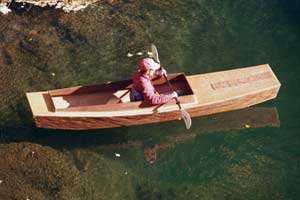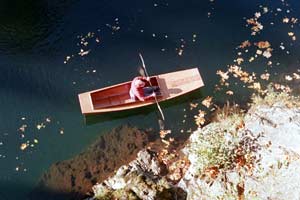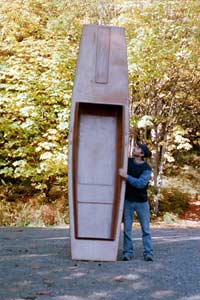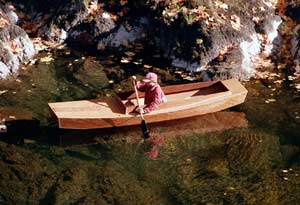|
Duck Boat
design by Paul Butler
www.butlerprojects.com/
Recently published in Outdoor Life Magazine, this is an updated and lightweight version of a market-hunter design. The prototype was built for a friends father, a retired Air Force Colonel and avid sportsman, who clipped an old hunting magazine describing the boat and brought it to our shop. We built a modified version in hardwood ply and epoxy.
The Colonel was a past president of the local Ducks Unlimited, and when we built this boat for him he was almost 80 years old. He could haul this lightweight in back of his truck, cartop it on racks, or even let it hang out his station wagon. The boat also has a slippery graphite bottom so he could drag the hull like a sled, across parking lots, up and down launch ramps and over logs--no lifting required.

(click pictures for larger versions)
This type of boat was known variously as a scullboat, sneakboat, a poke boat when poled standing up, and layout boat when reclining or crouching to lower the visual profile. The shape is similar to the bateau design popular in the south, although this hull has slightly more rocker. The rocker adds stability when standing and makes it easier to "park" the boat against the shore or to nestle down in reeds or cattails.
With a bulkhead cut-out the boat will support two adults but only on calm and sheltered water. The cut-out allows one adult to extend legs into the bow section providing more room aft for a second person. Its ideal for a single hunter and a dog, an adult and a kid, or a hunter with a load of decoys. Getting comfortable in the boat for long periods requires a folding air mattress seat with a backrest. Rain gear is useful and maybe a poncho to clamp over the cockpit coamings, and a hot thermos of coffee completes the package.

Row, paddle or scull? Traditional rowing with two oars is probably the most efficient muscle powered method for covering distance. Oars as short as four feet will work, but for getting there faster 6 foot oars are best and can still be stowed inside the boat. A double bladed paddle also works well and requires no oarlocks, and the boat may also be "sculled" with a single oar nestled in a transom notch or extended through a hole in the transom. The long keel provides directional stability when sculling,rowing or motoring. In close to the birds, hunters would crouch or lay down and disguise the boat with netting, limbs and branches. Drifting close to a raft of ducks these boats are sometimes propelled with ping-pong paddles to prevent spooking the birds and crafty hunters brag of sculling right through a raft of ducks. The smallest of electric motors will also push the hull right along.

Building the boat is straightforward using epoxy and the hull can be as light as 50 pounds, which makes it an easy cartopper. The plans are written for amateurs and first-timers and contain sketches, photos, materials sources, builders tips and a discussion of many options to modify and customize the boat. The cockpit can be made smaller for more weather protection or larger for easy access. Hinged or screw-out hatches may be added as required and sealed flotation compartments can be used for dry storage and to provide emergency flotation should the boat be accidently swamped.

Want to buy the plans?
Send $26.00, check or money order to:
Paul Butler
PO Box 1917
Port Angeles WA 98362
Questions? Email us at paul@butlerprojects.com
|

